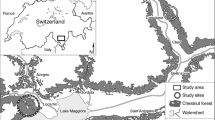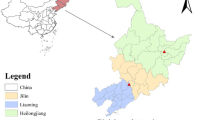Abstract
• Context
Despite the economic importance of Castanea sativa Mill. in northwest Spain, studies of its growth and yield are practically non-existent.
• Aims
A compatible system formed by a taper function, a total volume equation, and a merchantable volume equation was developed for chestnut (C. sativa Mill.) coppice stands in northwest Spain.
• Methods
Data from 203 destructively sampled trees were used for the adjustment. Outliers were removed with a non-parametric local adjustment, providing a final data set of measurements taken from 3,188 sections which was used to test five taper models (compatible and non-compatible). A second-order continuous autoregressive error structure was used to model the error term and account for autocorrelation. Presence of multicollinearity was evaluated with the condition number. Comparison of the models was carried out using overall goodness-of-fit statistics and graphical analysis.
• Results
Results show that the models developed by Fang et al. in For Sci 46: 1–12, 2000 and Kozak in For Chron 80, N 4: 507–515, 2004 were superior to other equations in predicting diameter for chestnut coppice stands.
• Conclusion
The compatible volume system developed by Fang et al. in For Sci 46: 1–12, 2000 was finally selected as it provided the best compromise between describing stem profile and also estimating merchantable height, merchantable volume, and total volume and therefore provides the first specific tool for more effective management of chestnut coppice stands.










Similar content being viewed by others
References
Álvarez P, Barrio M, Castedo F, Díaz R, Fernández JL, Mansilla P, Pérez R, Pintos C, Riesgo G, Rodríguez R, Salinero MC (2000) Manual de selvicultura del castaño en Galicia. University of Santiago Press, Santiago, España
Barrio-Anta M, Diéguez-Aranda U, Castedo-Dorado F, Álvarez-González JG, Von Gadow K (2007) Merchantable volume system for pedunculate oak in northwestern Spain. Ann For Sci 64:511–520. doi:10.1051/forest:2007028
Belsey DA (1991) Conditioning diagnostics, collinearity and weak data in regression. Wiley, New York
Bi H (2000) Trigonometric variable-form taper equations for Australian eucalypts. For Sci 46:397–409
Brink C, Gadow KV (1986) On the use of growth and decay functions for modeling stem profiles. EDV in Medizin u Biologie 17:20–27. doi:10.1080/02827580410019562
Burkhart H (1977) Cubic-foot volume of loblolly pine to any merchantable top limit. Sout J Appl For 1:7–9
Clutter JL (1980) Development of taper functions from variable-top merchantable volume equations. For Sci 26:117–120
Conedera M, Manetti MC, Giudici F, Amorini E (2004) Distribution and economic potential of the sweet chestnut (Castanea sativa Mill.) in Europe. Ecologia Mediterranea 30:179–193
Crecente-Campo F, Rojo A, Diéguez-Aranda U (2009) A merchantable volume system for Pinus sylvestris L. in the major mountain ranges of Spain. Ann For Sci 66:808. doi:10.1051/forest/2009078
Demaerschalk J (1972) Converting volume equations to compatible taper equations. For Sci 18:241–245
DGCONA (2013). III Mapa Forestal de España. MFE50. 1:50000. Ministerio de Medio Ambiente, Madrid, España
Díaz Varela RA, Calvo Iglesias MS, Díaz Varela ER, Ramil Rego P, Crecente Maseda R (2009) Castanea sativa forests: a threatened cultural landscape in Galicia NW Spain. In: O’Connell M, Küster H (eds) Cultural Landscapes of Europe. Fields of Demeter Haunts of Pan (Krzywinski K. Aschembeck Media UG, Bremen, pp 94–95
Diéguez-Aranda U, Castedo-Dorado F, Álvarez-González JG, Rojo A (2006) Compatible taper function for Scots pine plantations in northwestern Spain. Can J For Res-Rev Can Rech For 36:1190–1205. doi:10.1139/X06-008
Diéguez-Aranda U, Rojo Alboreca A, Castedo-Dorado F, Álvarez-González JG, Barrio-Anta M, Crecente-Campo F, González-González JM, Pérez-Cruzado C, Rodríguez-Soalleiro R, López-Sánchez CA, Balboa-Murias MA, Gorgoso Varela JJ, Sánchez Rodríguez F (2009). Consellería do Medio Rural, Xunta de Galicia. 268 pp + CD-Rom.
Fang Z, Bailey RL (1999) Compatible volume and taper models with coefficients for tropical species on Hainan Island in Southern China. For Sci 45:85–100
Fang Z, Borders BE, Bailey RL (2000) Compatible volume-taper models for loblolly and slash pine based on a system with segmented-stem form factors. For Sci 46:1–12
Gallardo JF, Rico M, González MI (2000) Some ecological aspects of a chestnut coppice located at the Sierra de Gata mountains (Western Spain) and its relationships with a sustainable management. Ecologia Mediterranea 26:53–69
Giudici F, Amorini E, Manetti MC, Chatziphilippidis G, Pividori M, Sevrin E, Zingg A (2000) Sustainable management of sweet chestnut (Castanea sativa Mill.) coppice forest by means of the production of quality timber. Ecologia Mediterranea 26:8–26
Goulding CJ, Murray J (1976) Polynomial taper equations that are compatible with three volume equations. N Z J For Sci 5:313–322
Huang S, Yang Y, Wang Y (2003) A critical look at procedures for validating growth and yield models. In: Amaro A, Reed D, Soares P (eds) Modelling forest systems. CAB International, Wallingford, Oxfordshire, UK
Kerr G, Evans J (1993). Growing broadleaves for timber. Forestry Commission Handbook 9, London.
Kozak A (1988) A variable-exponent taper equation. Can J For Res-Rev Can Rech For 18:1363–1368. doi:10.1139/X88-213
Kozak A (2004) My last words on taper equations. For Chron 80:507–515. doi:10.5558/tfc80507-4
Kozak A, Kozak R (2003) Does cross validation provide additional information in the evaluation of regression models? Can J For Res 33:976–987. doi:10.1139/X03-022
Lindstrom MJ, Bates DM (1990) Nonlinear mixed effects models for repeated measures data. Biometrics 46:673–687. doi:10.2307/2532087
MARM (2011) Avance del Anuario de Estadística Forestal. Área de Medio Ambiente, Madrid, España
Muhairwe CK (1994) Tree form and taper variation over time for interior lodgepole pine. Can J For Res 24:1904–1913. doi:10.1139/X94-245
Myers RH (1990) Classical and modern regression with applications, 2nd edn. Duxbury Press, Belmont, CA
Pompa-García M, Corral-Rivas JJ, Hernández-Díaz JC, Álvarez-González JG (2009) A system for calculating the merchantable volume of oak trees in the northwest of the state of Chihuahua, Mexico. J For Res 20:293–300. doi:10.1007/s11676-009-0051-x
Reed DD, Green E (1984) Compatible stem taper and volume ratio equations. For Sci 30:977–990
Riemer T, Gadow KV, Sloboda B (1995) Eim modell zur Beschreibung von Baumschäften. Allg Forst Jagdztg 166:144–147
Rodríguez F, Broto M, Lizarralde I (2008). CubiFOR: herramienta para cubicar, clasificar productos, calcular biomasa y CO2 en masas forestales de Castilla y León. Revista Montes: 33–3
SAS Institute Inc (2004a) SAS/STAT®, 0.1. User’s Guide. SAS Institute Inc., Cary, NC
SAS SAS Institute Inc (2004b) SAS/ETS®, 0.1. User's Guide. SAS Institute Inc., Cary, NC
Thomas CE, Parresol BR (1991) Simple, flexible, trigonometric taper equations. Can J For Res 21:1132–1137. doi:10.1139/X91-157
Weisberg S (1985) Applied linear regression, 2nd edn. Wiley, Inc
Zhang D (1997) Cross-validation of non-linear growth functions for modeling tree height-diameter relationships. Ann Bot 79:251–257. doi:10.1006/anbo.1996.0334
Zimmerman DL, Núñez-Antón V (2001) Parametric modeling of growth curve data: an overview (with discussion). Test 10:1–73. doi:10.1007/BF02595823
Acknowledgments
The authors thank Forest Services (Government of the Principality of Asturias) and the private owners who allowed the establishment of the permanent plots necessary for the development of the study. The authors are grateful to the University of Oviedo, which provided the validation data.
Funding
This study was supported by the Spanish Ministry of Science and Innovation (MICIN) and the Plan for Science, Technology and Innovation of the Principality of Asturias (PCTI) as part of the research project “Forest and industrial evaluation of Spanish chestnut” (VALOCAS).
Author information
Authors and Affiliations
Corresponding author
Additional information
Handling Editor: Aaron R Weiskittel
Contribution of the co-authors
María Menéndez-Miguélez supervised field work, analyzed data and wrote the paper. Elena Canga designed data collection, analyzed data, and reviewed the paper. Pedro Álvarez-Álvarez contributed to the discussion of the results and reviewed the paper. Juan Majada coordinated the research project.
Rights and permissions
About this article
Cite this article
Menéndez-Miguélez, M., Canga, E., Álvarez-Álvarez, P. et al. Stem taper function for sweet chestnut (Castanea sativa Mill.) coppice stands in northwest Spain. Annals of Forest Science 71, 761–770 (2014). https://doi.org/10.1007/s13595-014-0372-6
Received:
Accepted:
Published:
Issue Date:
DOI: https://doi.org/10.1007/s13595-014-0372-6




